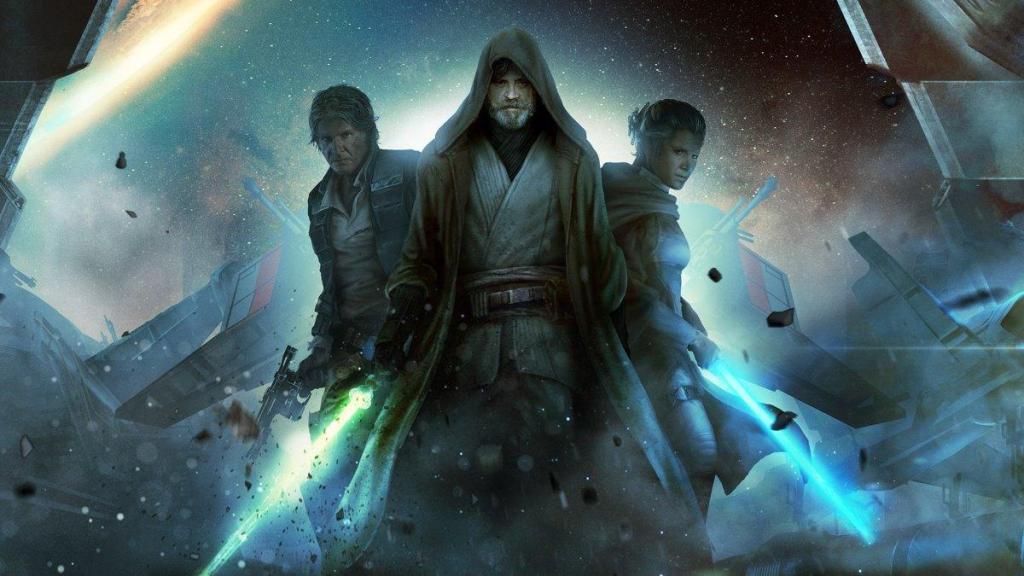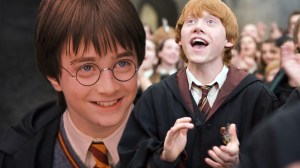Star Trek’s expanded universe isn’t going out the way that the Star Wars EU did. In September, Simon & Schuster released Moments Asunder by Dayton Ward. The novel is the first installment of the , which will serve as the swan song for the shared universe of Star Trek novels that continued the adventures of the characters from Star Trek: The Next Generation, Deep Space Nine, and Voyager past those shows’ finales for more than a decade. That means Star Trek’s old post-screen continuity is getting a proper ending, which Disney never provided for the old Star Wars continuity that preceded its acquisition of Lucasfilm.
Videos by ComicBook.com
If you want a sense of how abruptly Disney’s ending of the Star Wars EU came about, the last novel published in that continuity was 2014’s Honor Among Thieves, intended as the second installment of a planned trilogy. The third book in that trilogy, Heir to the Jedi, was released a year later and is considered part of Disney’s new canon despite being announced in 2012 before Disney even revealed it would buy Lucasfilm. The closest the EU got to a finale was 2013’s Crucible by Troy Denning, which takes place farther into Star Wars’ future than any other Star Wars novel and sees Luke, Leia, Han, and Lando reunite for one last adventure. But most fans seem to agree that, while it’s a fine standalone novel, it didn’t quite carry the weight of a finale more than 20 years in the making, especially since it debuted almost a full year before the EU’s ending was announced.

Now marketed under the Star Wars Legends banner, the old Star Wars Expanded Universe gained notoriety in 1991. Eight years after Return of the Jedi ended the original Star Wars trilogy, Bantam Spectra published Timothy Zahn’s Heir to Empire. The novel continues Luke, Leia, and Han’s adventures after Emperor Palpatine’s defeat. Later that same year, Dark Horse Comics began serializing Dark Empire, a new comic book series in the same continuity as Bantam Spectra’s Star Wars novels. Together, these new stories revived interest in Star Wars and established a shared universe of continuing adventures.
What would come to be known as the Star Wars Expanded Universe would sustain Star Wars fans for decades, even after inspiring George Lucas’ return to his creation to write and direct the prequel trilogy. Though it is no longer canon, ideas from the old expanded universe continue to influence new Star Wars works.
That the EU, arguably, saved Star Wars, sustaining it long enough to become something of interest to Disney, makes the lack of closure given to that old universe almost ironic, if not outright sad. The writers behind the Star Trek equivalent to that universe didn’t want the same thing to happen to the continuity they’d tended for years.
“Those of us who pay attention to such things saw what happened when Disney acquired Star Wars from Lucasfilm and decades of novels, comics, and other ‘expanded universe’ media were summarily reclassified as ‘Legends,’ with storylines ended or simply left unresolved as new films were put into production,” Ward wrote in a blog post discussing Star Trek: Coda‘s genesis. “In many ways it was a ‘clean slate’ so far as tie-in efforts were concerned. After being told for years that all of this material ‘mattered’ and was even considered ‘canon’ (albeit on a ‘level’ different from that of the Star Wars films), this sudden paradigm shift came as something of a shock, and for some it even felt more than a bit like betrayal.”

Star Trek’s novels have never been considered any level of official canon in the franchise. Stewards of the brand have always said that the only official Star Trek continuity is what appears on television and in films. As such, Ward admits in his afterward to Moments Asunder that “the challenge we were facing with the Star Trek novels was not on that scale.” Despite that, he “very much wanted them to avoid a repeat of the Star Wars situation.” That led to him collaborating on fellow Star Trek novelists James Swallow and David Mack on Star Trek: Coda‘s pitch, ultimately earning ViacomCBS and Simon & Schuster’s approval.
It may be because it made no claims to being canon that the Star Trek literary universe hasn’t achieved the same stature as its Star Wars counterpart. Or maybe it’s because it never saved the franchise, as Star Trek has never needed saving. Even when , and there were no new Star Trek shows set to go into production, there were still rumblings of projects in development for television and film. Star Trek might have been changing and taking a break, but it wasn’t going away.
But the lack of an immediate continuation presented Star Trek’s novelists with a unique opportunity. They were able to give the novel line a soft reboot. What was once several distinct, more-or-less episodic series based on the different television shows set in the 24th century became a cohesive shared universe. In that form, the writers pushed Star Trek’s story past the events of Star Trek: Nemesis, then the furthest point in Star Trek’s canon. With Paramount Pictures’ then-upcoming J.J. Abrams-helmed Star Trek being a reboot set in another timeline, the authors were free to take the old universe of the TV shows in whatever direction they wanted without worrying about lining up with any forthcoming projects.
Though the post-Nemesis experiment began with the 2005 Star Trek: The Next Generation novel Death in Winter, the stories told in those novels referenced past stories published as far back as 2002. Taken all together, that’s almost two decades of Star Trek storytelling that took some big swings. Picard participated in a conspiracy to oust a sitting Federation president, the Andorians seceded from the Federation, and an alliance of Starfleet antagonists blew up Deep Space 9.

But then Star Trek came to streaming. First, it was Star Trek: Discovery, which didn’t seem like too much of a problem. After all, Discovery , set more than a century before Star Trek: Nemesis. The novelists could probably work around whatever new ideas the show introduced into the Star Trek canon with that much distance.
But then Patrick Stewart got up on stage at Star Trek Las Vegas in 2008 and announced he’d be back as Jean-Luc Picard, continuing Picard’s story in canon in a new streaming series. That was the beginning of the end for the Star Trek novel universe.
“We knew that once a show featuring Jean-Luc Picard went into development, it would almost inevitably establish events and character actions that would be irreconcilable with our literary continuity,” David Mack wrote in a blog post about Coda. He’s writing the trilogy’s final novel, Oblivion’s Gate. “Which put us in a tough spot. Star Trek tie-in fiction, like that of most other licensed properties, is required to be consistent with the canon version of the property, as it exists at the time the tie-in material is written. The more we learned about the back story of Picard, the more we realized there was no way to reconcile or retcon our 20 years of narrative with what was coming. One way or another, our communal literary project was soon to end.”
He continued, “I and others behind the scenes knew we had to make a choice. Either let the story be abandoned in medias res — or steer into the wave and craft an ending worthy of two decades of work. We chose the second option.”
And so, the Star Trek post-finale universe will have a finale of its own, bringing closure to 20 years of Star Trek stories. It’s a story dealing with broken time, so who knows how it may, or may not, dovetail with the canon version of Star Trek’s future.
And the Star Trek line of novels isn’t ending. Simon & Schuster still plans to publish more stories based on The Next Generation, Deep Space Nine, and Voyager. They’ll be focused on established canon, likely taking place between episodes, rather than extending beyond those series’ ends. As with the larger Star Trek franchise back when the post-Nemesis experiment started, the novel line will change, but it isn’t going away.
As for Star Wars, is it too late to give the old Expanded Universe a proper ending? For a time, it seemed like Disney might ignore the old canon entirely to avoid brand confusion, but the sequel trilogy left the tie-in novels in a bind. The Last Jedi is the only Star Wars movie ever to take place immediately after the end of its predecessor. That means there aren’t years worth of untold stories for novels to explore between those films, as there were with all of the movies in the original and prequel trilogies, and a single book, Resistance Reborn, covered the gap between The Last Jedi and The Rise of Skywalker. Disney isn’t going to let tie-in novels continue the story past The Rise of Skywalker. With Marvel’s Star Wars comics covering the gaps in the original trilogy and Star Wars animation supplementing the prequel trilogy, that doesn’t leave much left for the novels.
The Star Wars novels have adjusted in a couple of ways. The High Republic, providing Star Wars novelists with a segment on the Star Wars timeline far enough removed from any of the film trilogies that they’re able to drive the narrative almost entirely.

The second is reprinting old Expanded Universe books. While a few notable Legends novels remained in print previously, Lucasfilm’s publishing arm took things a step further by launching the Star Wars Legends Essentials Collection earlier this year. The new line gives old EU favorites new printings with new covers. It’s one sign that Disney may be warming to the old EU, with another being the Star Wars Vintage collection on Disney+, featuring works of non-canon Star Wars television, including the original .
Disney isn’t likely to reinstate that old Expanded Universe as canon. Still, supposing you’re a wishful thinker, you might wonder if Lucasfilm could greenlight a new book project that would give the old Legends continuity a proper sendoff during this relatively quiet period for Star Wars movies. It would be one last tale set in the old continuity, offering closure where there previously was none. There are no rumors or reports of such a project at present, but Lucasfilm has surprised fans before. (And regardless of what Disney does in the future with the Expanded Universe, it should pay those writers.)
What do you think? Let us know in the comments. Star Trek: Coda — Moments Asunder is on sale now.
A previous version of this story cited Timothy Zahn as the author of Star Wars: Crucible instead of Troy Denning. We regret the error, which has been fixed. The article remains otherwise as initially published.









